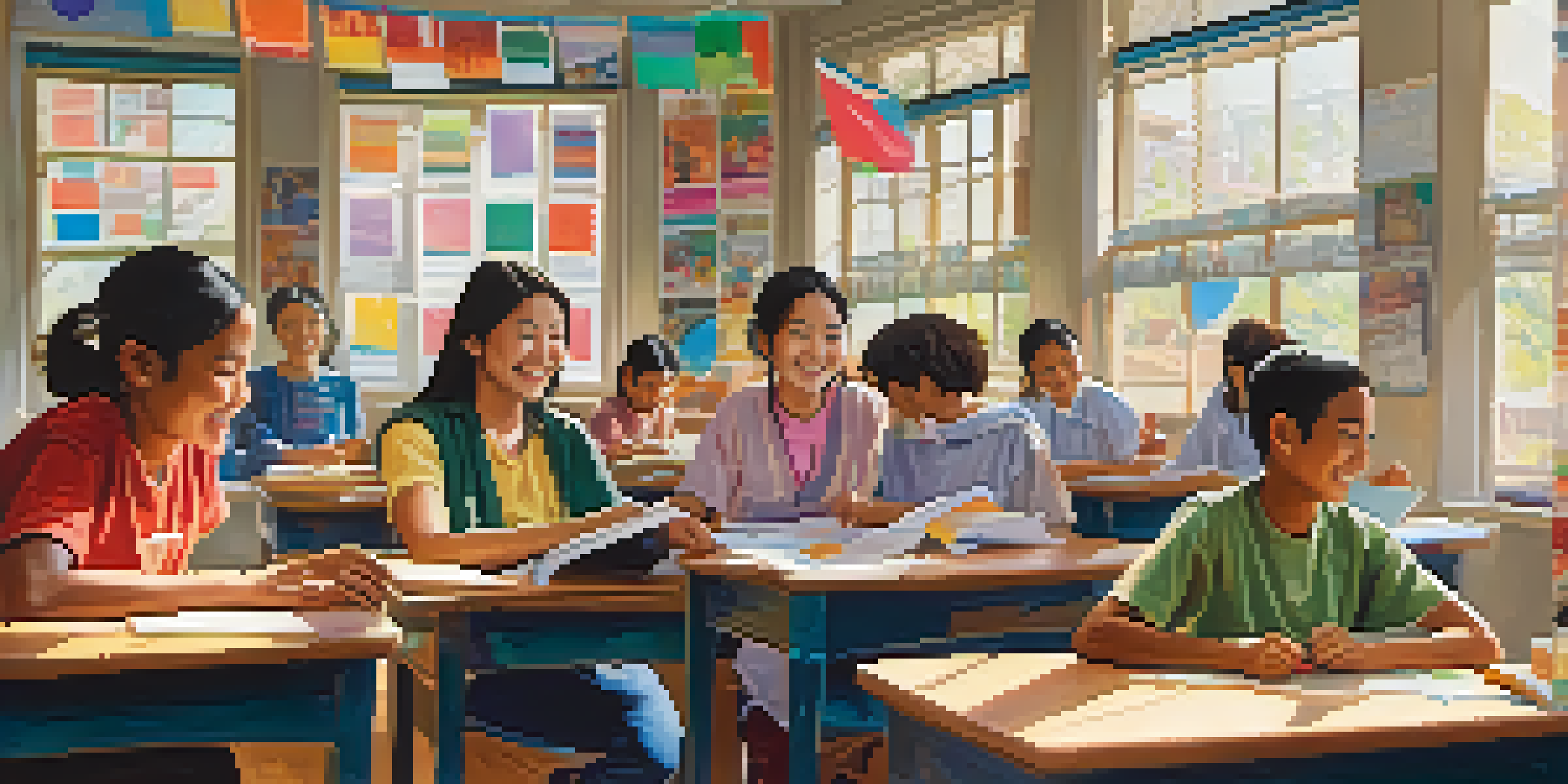The Role of Teachers in Culturally Responsive Education

Defining Culturally Responsive Education
Culturally responsive education (CRE) is an approach that recognizes the importance of including students' cultural references in all aspects of learning. This method doesn’t just acknowledge diversity; it embraces it, creating a richer educational experience for all. For instance, when a teacher incorporates stories from various cultures into their curriculum, students from those backgrounds feel seen and valued.
Education is not the filling of a pail, but the lighting of a fire.
Moreover, CRE is not just a teaching strategy; it's a mindset that encourages educators to engage with students’ backgrounds actively. Teachers who understand and appreciate their students' cultural contexts can make learning more relatable and effective. This engagement can lead to increased participation and motivation among students, particularly those from underrepresented groups.
Ultimately, defining culturally responsive education sets the stage for understanding the crucial role teachers play in this framework. By fostering an inclusive environment, teachers can ensure that learning is not just a one-size-fits-all approach, but rather a tailored experience that resonates with each student.
The Teacher's Role as Cultural Mediator
Teachers serve as cultural mediators, bridging the gap between diverse student backgrounds and the curriculum. This role requires them to not only understand their students' cultures but also to translate those cultural insights into teaching practices. For example, a teacher might adapt lesson plans to include examples that reflect the cultural backgrounds of their students, making lessons more engaging.

In this capacity, teachers can facilitate discussions that allow students to share their cultural experiences, fostering a sense of belonging. By encouraging this exchange, teachers help students see the value of their unique perspectives, which can enrich classroom dynamics. This not only enhances learning but also promotes empathy and understanding among peers.
Culturally Responsive Education Defined
Culturally responsive education (CRE) incorporates students' cultural backgrounds into the learning process, enriching the educational experience for everyone.
Being a cultural mediator is a dynamic aspect of a teacher's role, requiring ongoing learning and adaptation. As global citizens, teachers must be aware of cultural shifts and evolving student demographics to effectively support their diverse classrooms.
Building Relationships with Students and Families
A key component of culturally responsive education is the relationship between teachers, students, and their families. When teachers take the time to understand and connect with families from different cultural backgrounds, they create a supportive network that benefits students. This could mean hosting community events or simply reaching out for informal chats to learn about students' home lives.
The beautiful thing about learning is that no one can take it away from you.
These relationships help build trust, which is essential for effective teaching and learning. Students who feel valued and understood are more likely to engage actively in their education. For instance, a teacher who knows about a student’s cultural celebrations can incorporate those into the classroom, making learning more personalized.
Ultimately, strong relationships foster an inclusive atmosphere where students feel safe to express themselves. By prioritizing these connections, teachers can effectively contribute to a culturally responsive educational environment.
Adapting Curriculum to Reflect Diversity
Teachers play a crucial role in adapting the curriculum to reflect the diverse cultures present in their classrooms. This adaptation goes beyond simply adding multicultural books; it's about integrating various perspectives throughout all subjects. For example, in a history lesson, a teacher might include stories from multiple cultures to provide a more balanced view of historical events.
This kind of curriculum adaptation not only enriches the students' learning experience but also challenges stereotypes and biases. When students see themselves represented in the material they study, it boosts their confidence and academic performance. A math lesson that incorporates culturally relevant examples can resonate more with students, making concepts clearer and more interesting.
Teachers as Cultural Mediators
Teachers play a crucial role as cultural mediators, adapting their teaching practices to bridge the gap between diverse student backgrounds and the curriculum.
By continuously revising and enhancing the curriculum, teachers ensure that all students feel acknowledged and valued in their learning journey. This proactive approach is essential for fostering a culturally responsive educational environment.
Encouraging Critical Thinking and Dialogue
A vital part of culturally responsive education is fostering critical thinking and open dialogue among students. Teachers can create a safe space for students to express their views and ask questions about cultural differences and social issues. For instance, by facilitating discussions on current events or controversial topics, teachers can encourage students to think deeply and consider multiple perspectives.
These conversations not only enhance critical thinking skills but also promote a culture of respect and understanding. Students learn to appreciate diverse viewpoints, which is essential in our increasingly global society. A classroom that values dialogue empowers students to become thoughtful and informed citizens.
By integrating critical thinking and dialogue into their teaching, educators help students develop skills that extend beyond academics. This prepares them for future challenges in a diverse world, making culturally responsive education a cornerstone of holistic development.
Professional Development for Teachers
To effectively implement culturally responsive education, teachers must engage in ongoing professional development. This training equips educators with the tools and strategies needed to understand and address the unique needs of their diverse students. Workshops on cultural competence, for example, can provide valuable insights into different cultural norms and teaching methods.
Additionally, collaboration among educators can foster a supportive learning community where teachers share best practices and experiences. By learning from one another, teachers can enhance their understanding of culturally responsive teaching and refine their approaches. This collaborative spirit is vital in creating an inclusive educational environment.
Importance of Building Relationships
Strong relationships between teachers, students, and families foster trust and create a supportive network that enhances student engagement and learning.
Ultimately, investing in professional development is an investment in the students’ futures. Educators who continuously seek to improve their cultural responsiveness contribute significantly to a nurturing and effective learning atmosphere.
Measuring the Impact of Culturally Responsive Education
Measuring the impact of culturally responsive education can be complex, but it’s essential for understanding its effectiveness. Teachers can collect data through surveys, student feedback, and academic performance metrics to gauge how well their culturally responsive strategies are working. For example, an increase in student engagement and participation could indicate that the approach is resonating with the class.
Moreover, qualitative assessments, such as student reflections and personal stories, can offer deeper insights into the impact of culturally responsive teaching. These narratives can highlight the emotional and social benefits that students experience, which are often just as important as academic achievements. Teachers can use this information to adjust their practices and ensure that they meet their students’ evolving needs.

By measuring the impact, educators can advocate for the importance of culturally responsive education within their schools and communities. Sharing success stories and data can help garner support for these initiatives, ensuring that all students receive the enriching educational experience they deserve.